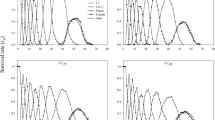Abstract
The solitary, endoparasitic ichneumonid,Hyposoter exiguae (Viereck) is a parasitoid of the tomato fruitworm,Heliothis zea (Boddie). However, the parasitoid is deleteriously affected by the tomato glycoalkaloid, α-tomatine, ingested from hosts (H. zea) fed on artificial diets or semipurified extracts of tomato plants that contained α-tomatine. α-Tomatine causes prolonged larval development; disruption or prevention of pupal eclosion; deformation of antennal, abdominal, and genital structures; and reduction in adult weight and longevity of the parasitoid. These toxic effects are exacerbated when the dietary dose of α-tomatine is increased from 12 μmol to 20 μmol/g dry wt of diet. However, the toxicity of α-tomatine is attenuated in parasitoids reared from hosts fed on artificial diets that contain equimolar or supramolar amounts of 3β-OH-sterols admixed with α-tomatine. Further, the toxicity of extracts from the foliage of different cultivars of tomatoes toH. exiguae is contingent upon the composite levels of α-tomatine and total phytosterol (free and esterified). Cultivars with a low total sterol-tomatine ratio are more toxic toH. exiguae. The possible mode of action of α-tomatine toxicity toH. exiguae by disruption of sterol metabolism is discussed.
Similar content being viewed by others
References
Abell, L.L., Levy, B.B., Brodie, B.B., andKendall, F.E. 1952. A simplified method for the estimation of total cholesterol in serum and demonstration of its specificity.J. Biol. Chem. 195:357–366.
Brown, D., andKeeler, R.F. 1978. Structure-activity relation of steroid teratogens. 3. Solanidan epimers.J. Agric. Food Chem. 26:566–569.
Campbell, B.C., andDuffey, S.S. 1979a. Tomatine and parasitic wasps: Potential incompatibility of plant antibiosis with biological control.Science 205:700–702.
Campbell, B.C., andDuffey, S.S. 1979b. Effect of density and instar ofHeliothis zea on parasitization byHyposoter exiguae.Environ. Entomol. 8:127–130.
Canarday, T.D., Tood, J.W., andDilbeck, J.D. 1969. Evaluation of tomatoes for fruitworm resistance.J. Ga. Entomol. Soc. 4:51–54.
Carroll, K.K. 1961. Separation of lipid classes by chromatography on florisil.J. Lipid Res. 2:135–141.
Cosenza, G.W., andGreen, H.B. 1979. Behavior of the tomato fruitworm,Heliothis zea (Boddie), on susceptible and resistant lines of processing tomatoes.HortSci. 14:171–173.
Duffey, S.S.,Campbell, B.C., andIsman, M.B. 1980. Insect resistance.Annu. Report Calif. Fresh Mrkt. Tomato Adv. Brd., pp. 159–171.
Feeny, P.P. 1968. Effect of oak leaf tannins on larval growth of winter mothOperophtera brumata.J. Insect Physiol. 14:805–817.
Fery, R.L., andCuthbert, F.P., Jr. 1973. Factors affecting evaluation of fruitworm resistance in the tomato.J. Am. Soc. Hortic. Sci. 98:457–459.
Fery, R.L., andCuthbert, F.P., Jr. 1974. Resistance of tomato cultivars to the fruitworm (Heliothis zea).HortSci. 9:469–470.
Fowlkes, E.R., Leben, C., andSnell, J.R. 1967. Sterols in relation to the influence ofNystatin onPythium aphanidermaium andCollectotrichum lagenarium.Phytopathology 57:246–249.
Fraenkel, G. 1959. The raison d'etre of plant secondary substances.Science 129:1466–1470.
Jansen, D.H. 1971. Escape of juvenileDioclea megacarpa (Leguminosae) vines from predators in a deciduous tropical forest.Am. Nat. 105:97–112.
Mangold, H.K., andMalins, D.C. 1960. Fractionation of fats, oils, and waxes on thin layers of silicic acid.J. Am. Oil Chem. Soc. 37:383–385.
McKee, R.K. 1959. Factors affecting the toxicity of solanine and related alkaloids toFusarium caeruleim.J. Gen. Microbiol. 20:686–696.
McKey, D., Waterman, P.G., Mbi, C.N., Gartlan, J.S., andStruhsaker, T.T. 1978. Phenolic content of vegetation in two African rain forests: Ecological implications.Science 202:61–64.
Metcalf, R.L., andFlint, W.P. 1962. Destructive and Useful Insects: Their Habits and Control, pp. 498–500. McGraw-Hill, New York.
Michelbacher, A.E., andEssig, E.O. 1930. Caterpillars attacking tomatoes.Calif. Agric. Exp. Stn. Bull. 625.
Puttler, B. 1961. Biology ofHyposoter exiguae (Hymenoptera: Ichneumonidae); A parasite of lepidopterous larvae.Ann. Entomol. Soc. Am. 54:25–30.
Robbins, W.E., Kaplanis, J.N., andSvoboda, J.N. 1971. Steroid metabolism in insects.Annu. Rev. Entomol. 16:53–72.
Roddick, J.G. 1974. The steroidal glycoalkaloid, α-tomatine.Phytochemistry 13:9–25.
Roddick, J. 1979. Complex formation between solanaceous steroidal glycoalkaloids and free sterols in vitro.Phytochemistry 18:1467–1470.
Rouser, G., Kritchevsky, G., Heller, D., andLieber, E. 1963. Lipid composition of beef brain, beef liver, and the sea anenome: Two approaches to quantitative fractionation of complex lipid mixtures.J. Am. Oil Chem. Soc. 40:425–454.
Schultz, G., andSander, H. 1957. Uber Cholesterin-Tomatid, eine neue Molekulverbindung zur Analyse und Praparativen Gewinnung von Steroiden.Z. Physiol. Chem. 308:122–126.
Svoboda, J.A., Robbins, W.E., Cohen, C.F., andShortino, T.J. 1972. Phytosterol utilization and metabolism in insects: recent studies withTribolium confusum, pp. 505–516,in J.G. Rodriguez (ed.). Insect and Mite Nutrition. North-Holland, Amsterdam.
Svoboda, J.A., Thompson, M.J., Robbins, W.E., andKaplanis, J.N. 1978. Insect steroid metabolism.Lipids 13:742–753.
Vogel, A.I. 1967. A Textbook of Practical Organic Chemistry, 3rd ed. Longmans, London.
Wesp, E.F., andBrode, W.R. 1934. The absorption spectra of ferric compounds. I. The ferric chloride-phenol reaction.J. Am. Chem. Soc. 56:1037–1042.
Wilcox, J.A.,Howland, A.F., andCampbell, R.E. 1956. Investigations of the tomato fruitworm. Its seasonal history and methods of control.U.S.D.A. Tech. Bull. 1147.
Williams, W.G., Kennedy, G.G., Yamamoto, R.T., Thacker, J.D., andBordner, J. 1980. 2-Tridecanone: A naturally occurring insecticide from the wild tomatoLycopersicon hirsutum f.glabratum.Science 207:888–889.
Wilson, R.H., Poley, G.W., andDeeds, F. 1961. Some pharmacological and toxicological properties of tomatine and its derivatives.Toxicol. Appl. Pharmacol. 3:39–48.
Wyman, J.A.,Oatman, E.R., andJohnson, M.W. 1979. Key to efficient tomato production-insect pest management.Calif. Fresh Mkt. Tomato Adv. Brd. Info. Bull. 22.
Author information
Authors and Affiliations
Rights and permissions
About this article
Cite this article
Campbell, B.C., Duffey, S.S. Alleviation of α-tomatine-induced toxicity to the parasitoid,Hyposoter exiguae, by phytosterols in the diet of the host,Heliothis zea . J Chem Ecol 7, 927–946 (1981). https://doi.org/10.1007/BF00987618
Received:
Revised:
Issue Date:
DOI: https://doi.org/10.1007/BF00987618




